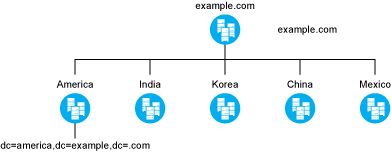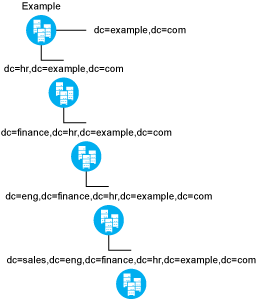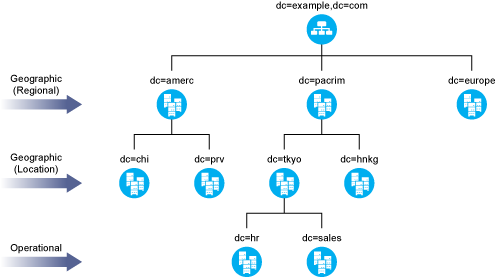4.1 Deploying DSfW in a Non-Name-Mapped Setup
A non-name-mapped setup refers to a setup that includes a new eDirectory Tree and a new DSfW forest as part of the DSfW installation. Before you start the process of installation, refer Installation Prerequisites For a Non-Name-Mapped Setup.
The scenarios explained here are only indicative of the various ways in which you can deploy DSfW server in your environment. Here the tree structure overlaps with the DNS namespace. For instance, the domain example.com will be mapped to dc=example,dc=com FQDN.
4.1.1 Deploying as a Single Domain
In this scenario, you have a single domain in the DSfW forest and have multiple DSfW servers acting as domain controllers in the domain.
Figure 4-1 Deploying DSfW as a Single Domain

In Figure 4-1 the example.com domain is served by 5 domain controllers.
4.1.2 Deploying as Multiple Domains in a Forest
Width
In this scenario, the DSfW forest is spread out in an horizontal manner. You can have each branch office of the company configured as a separate domain belonging to one single DSfW Forest.
As represented in the figure, example.com is the first domain in the DSfW forest. It represents the head office of the company and the branch offices are represented by domains, America, India, Korea, China and Mexico.
Figure 4-2 Deploying DSfW in a Horizontally Spread Tree

Depth
In this form of structuring, the tree is vertically structured and you can create different DSfW domains corresponding to each engineering and support function in the organization.
Figure 4-3 Deploying DSfW in a Vertically Structured Tree

Depth and Width
With this combination you get benefits of a tree that is spread both horizontally and vertically. This is best suited for organizations that have offices locally as well as globally and there is a high requirement for load processing.
Figure 4-4 Deploying DSfW in a Combination Structure
